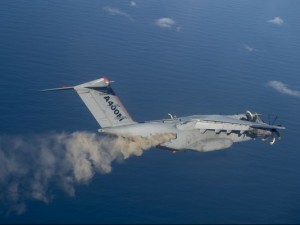 Engineers from Airbus and their customer Easyjet have teamed up to create an artificial ash cloud to test a sensor that could help avoid massive airspace closures after a volcanic eruption.
Engineers from Airbus and their customer Easyjet have teamed up to create an artificial ash cloud to test a sensor that could help avoid massive airspace closures after a volcanic eruption.
When a volcano erupted in Iceland in 2010, it filled the skies over Europe with a massive ash cloud. From April 15-21, 2010, more than 100,000 flights were cancelled as officials scrambled to assess safety. The closures cost the airlines an estimated $2.6 billion.Flights had to be cancelled because the ash can cause structural damage as it melts inside aircraft engines and sticks to engine blades. It also sticks to windshields and can interfere with other instruments. The ash is difficult to detect and track because it is incredibly fine.
Europe could see a repeat situation within the next couple of years, experts say, because Icelandic volcanoes erupt about once every five years. If the wind is blowing to the northwest, the ash ends up in European skies.But the next time it happens, pilots should be better equipped to assess the dangers, with the help of a new sensor designed to detect ash in the atmosphere. Engineered by European airline easyJet, aircraft maker Airbus, and Nicarnica Aviation, the Airborne Volcanic Object Identifier and Detector (AVOID) would be mounted on aircraft.
Airbus Creates Volcanic Ash Cloud Test
FOD Detection System In Israel
 The new FODetect foreign object debris (FOD) detection systems went operational in mid-May at Tel Aviv’s Ben-Gurion International Airport (LLBG). The equipment, developed by Israeli company Xsight Systems, was certified after an evaluation process and soft launch on Ben Gurion’s primary Runway that begun in August of 2012.
The new FODetect foreign object debris (FOD) detection systems went operational in mid-May at Tel Aviv’s Ben-Gurion International Airport (LLBG). The equipment, developed by Israeli company Xsight Systems, was certified after an evaluation process and soft launch on Ben Gurion’s primary Runway that begun in August of 2012.
“During the past nine months [of testing] an average of six items per month were collected from the runway,” said Yair Gannot, safety director with the Israel Airports Authority. “We had no case of FOD found by our manual inspectors that was not earlier detected and visualized by the automated FOD detection system,” he added.
FOD on a Boat
Foreign Object Damage – or FOD – costs the Navy almost $90 million a year. That’s why combating FOD is a priority for sailors on the San Diego-based USS Peleliu.
The Navy put together this video on how Pelieliu sailors do their part to scope out foreign objects, some smaller than a dime, to keep their ship running smoothly.
The USS Peleliu is currently deployed in the 5th Fleet area of responsibility.
FOD incident forces emergency landing of Air France A-330
 A tool left inside the engine of an Airbus 330 caused a mid-air engine snag shortly after take off in India, forcing the Paris-bound aircraft to return to the Mumbai city airport early on March 12th. There were 212 people on board the Air France flight.
A tool left inside the engine of an Airbus 330 caused a mid-air engine snag shortly after take off in India, forcing the Paris-bound aircraft to return to the Mumbai city airport early on March 12th. There were 212 people on board the Air France flight.
Air France has said the “foreign object” found in the engine hood had nothing to do with the engine dysfunction but others disagree.
About 10 minutes after the aircraft took off, the pilot reported smoke in the cabin and suspected a snag in one of the engines. The cockpit crew reported engine failure to the ATC tower and sought permission to land on priority. As per procedure, fire tenders, an ambulance and airfield vehicles were deployed, and the aircraft landed safely at 3.41am. Passengers were sent to a hotel.
A chisel-like tool used to lay a coating on engines to absorb its sound was found inside the engine hood, said sources from the DGCA who inspected the aircraft. The aviation safety regulator’s preliminary probe report said the tool inside the engine could have caused the dysfunction.
“It seems like the tool caused the snag and also disrupted the system used to maintain temperature and pressure within the cabin, which is why there was smoke,” said a source.
An aircraft maintenance engineer may have forgotten the tool during routine check, sources said.
An Air France-KLM spokesperson said: “An investigation will take place. The foreign object will be analyzed. According to available information, this object found in the engine hood has no link with the engine dysfunction.”
Keeping the Runway Clean Is Now a Little Easier
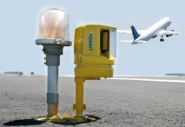
Israel’s Xsight has developed its new FODetect system to help airport managers keep runways clear during rainstorms or even in the middle of the night. Using a small swiveling radar transmitter and sensor unit installed near the runway’s edge, the FODetect beam sweeps the runway as often as every 30 seconds and, like traditional radar, highlights–both visually and aurally–objects as tiny as a rivet that may have fallen unnoticed from vehicles. The operator watching the FODetect screen will also see a high-resolution image of the object that caused the alarm. During nighttime hours, the unit uses a laser pointer to indicate objects on the runway to airport personnel. The crash of an Air France Concorde in July 2000 soon after takeoff from Paris Charles de Gaulle Airport was attributed to the supersonic jet running over a piece of metal that had fallen off the Continental Airlines DC-10 that departed just a few minutes before. The metal was not detected prior to the Air France flight taking the runway for takeoff.
Read More »
Many Runways need replacing; Tulsa’s overhaul is underway.
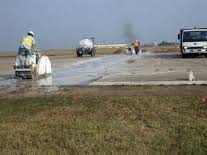 After 30 years, a runway begins to show its age.
After 30 years, a runway begins to show its age.
Repeated landings of 150,000-pound aircraft at Tulsa International Airport’s 10,000-foot main north-south runway have taken a toll on the pavement, airport executives said.
Last reconstructed in 1982, the main runway is undergoing a $19.9 million rehabilitation involving 7,000 feet of pavement. Two earlier phases of the runway reconstruction rebuilt 1,200 feet at the north and south ends of the runway.
The contractor, Interstate Highway Construction Inc. of Englewood, Colo., is scheduled to complete the runway work by May 15, barring weather delays.
The work includes pulverizing and hauling away the 18-inch-thick concrete and laying down 60,000 cubic yards of new concrete over an 18-inch-thick cement-treated rock base.
The runway reconstruction could not be postponed any longer, said Airports Director Jeff Mulder.
“The pavement is breaking up, creating FOD, which is bad for (aircraft) engines,” he said.
FOD is an acronym for foreign object debris or foreign object damage.
FOD is any object that does not belong in or near airplanes and, as a result, can damage airplanes or injure airport or airline workers, says the Federal Aviation Administration and Boeing Co., the airplane manufacturer.
FOD incidents cost the aerospace industry $4 billion a year, Boeing says.
FOD includes rocks, pavement fragments, hardware, catering supplies, building materials, sand, pieces of luggage and wildlife.
“FOD is found at terminal gates, cargo aprons, taxiways, runways and run-up pads,” Boeing says in a briefing paper “Foreign Object Debris and Damage Prevention.”
“It causes damage through direct contact with airplanes, such as by cutting airplane tires or being ingested into engines, or as a result of being thrown by jet blast and damaging airplanes or injuring people.”
The most famous incident involving FOD in recent years was the collision in New York City between a flock of migrating Canadian geese and US Airways Flight 1549 on Jan. 15, 2009.
The ingestion of the geese shut down both engines of the US Airways plane at 3,200 feet just after takeoff from LaGuardia Airport.
Without power, the Airbus A320 was reduced to a glider.
Fortunately, Capt. Chesley Sullenberger III was a veteran glider pilot and expert glider flight instructor.
Sullenberger guided the plane to a landing in the Hudson River between New York and New Jersey and all 150 passengers and crew were evacuated safely, news reports said.
But the bird strike in New York isn’t an isolated FOD incident, government and industry officials said.
Inspector General Urges Review Of FAA Wildlife Hazard Plans
Prompted by a scathing audit report by the Transportation Department inspector general about the ineffective implementation of its wildlife hazard plans, the FAA is analyzing comments it received on three draft advisory circulars. One of the ACs is new, but the other two are revisions of existing ACs.
The DOT IG had concluded that the FAA’s oversight and enforcement activities are not sufficient to ensure that airports fully adhere to program requirements or effectively implement their wildlife hazard plans. In addition, the FAA’s policies and guidance for monitoring, reporting and mitigating wildlife hazards are mostly voluntary, thereby limiting their effectiveness.
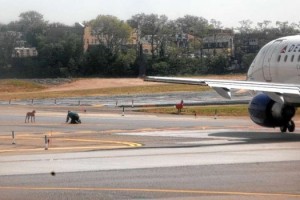 For example, the FAA recommends but does not mandate that airports and aircraft operators report all wildlife strikes to the FAA’s strike database. As a result, the agency’s strike data are incomplete, which affects its ability to evaluate the effectiveness of its program in reducing wildlife hazards.
For example, the FAA recommends but does not mandate that airports and aircraft operators report all wildlife strikes to the FAA’s strike database. As a result, the agency’s strike data are incomplete, which affects its ability to evaluate the effectiveness of its program in reducing wildlife hazards.
Finally, the FAA coordinates with the Agriculture Department’s Wildlife Services, its main partner in wildlife hazard mitigation, but its efforts to coordinate with other relevant government agencies are limited and infrequent.
The IG’s report should not have been news to the FAA. In 2009, the NTSB issued a safety recommendation to then-FAA Administrator Randy Babbitt indicating that the FAA should require all Part 139 airports and Part 121, Part 135 or Part 91 Subpart K aircraft operators to report all wildlife strikes, including species identification if possible, to the FAA National Wildlife Strike Database.
The new AC is titled “Protocol for the Conduct and Review of Wildlife Hazard Site Visits, Wildlife Hazard Assessments and Wildlife Hazard Management Plans.” The two revised ACs are “Hazardous Wildlife Attractants On or Near Airports” and “Reporting Wildlife Aircraft Strikes.”
February 4, 2013, 1:20 AM
Read More »
Can the FAA keep up with advancing technology?
The unfolding saga of Boeing’s highest-profile plane has raised new questions about federal oversight of aircraft makers and airlines. After two  separate and serious battery problems, it wasn’t U.S. authorities who acted first to ground the plane. It was Japanese airlines. Some aviation experts question the ability of the Federal Aviation Administration to keep up with changes in the way planes are being made today—both the technological advances and the use of multiple suppliers from around the globe. Others question whether regulators are too cozy with aircraft manufacturers.
separate and serious battery problems, it wasn’t U.S. authorities who acted first to ground the plane. It was Japanese airlines. Some aviation experts question the ability of the Federal Aviation Administration to keep up with changes in the way planes are being made today—both the technological advances and the use of multiple suppliers from around the globe. Others question whether regulators are too cozy with aircraft manufacturers.
Read more at: http://phys.org/news
Helicopter Hits Crane 80 Stories Above Downtown London
British Prime Minister David Cameron has ordered a review of the regulation of helicopter flights over central London in the wake of an accident January 16th in which an AgustaWestland AW109 Power crashed into a newly erected crane on a high-rise building in the UK capital’s Vauxhall district. The accident claimed the life of pilot Pete Barnes, the sole occupant of the helicopter, which was being operated by UK-based charter firm RotorMotion. Also killed was the driver of a car hit when the aircraft crashed to the ground just before 8 a.m. after striking the 770-foot-high crane, which had been the subject of a January 7 notam.
The crash site is less than a mile from Britain’s Houses of Parliament and a few blocks from the headquarters of the country’s MI6 intelligence services, prompting early speculation that the crash had been an act of terrorism. This theory was quickly dismissed, and the UK Air Accidents Investigation Branch has moved the wreckage of the AW109 to its Farnborough headquarters.
One early question raised by a senior London police officer was whether or not the crane had carried the required emergency warning lights. In fact, the notam indicates that the crane was “not lit.” Barnes had been flying from Redhill to collect a passenger at Elstree and had requested a diversion to the London Heliport.
FOB = Fool On Bike
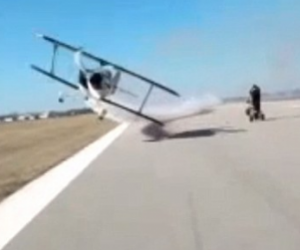 An aircraft came within inches of crashing into an unidentified man riding his quad bike on a runway, while his unidentified female friend filmed him (video below).
An aircraft came within inches of crashing into an unidentified man riding his quad bike on a runway, while his unidentified female friend filmed him (video below).
Seconds earlier, the man was having fun and performed a wheelie on the vehicle, reports the Daily Mail.
However, as he rides down the runway, an aircraft approaches.
The female, who is operating a video camera, is soon heard screaming as the plane gets closer.
The plane narrowly misses the man, leaving a trail of fumes behind.
The plane twists in midair and comes close to hitting the female, who is heard saying: “Oh my God…holy sh*t.”
The video is reminiscent of a famous scene from the 1959 film ‘North by Northwest,’ when Cary Grant is chased by an airplane.
Fire, Fuel Leak Add to Dreamliner’s Woes
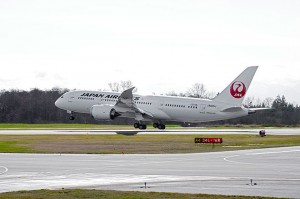 The new year is off to a rough start for Boeing’s new 787 Dreamliner, with one plane catching fire and another being sidelined by a fuel leak discovered just after it left the gate.
The new year is off to a rough start for Boeing’s new 787 Dreamliner, with one plane catching fire and another being sidelined by a fuel leak discovered just after it left the gate.
The problems started January 8th at Boston’s Logan International Airport when a 787 operated by Japan Airlines experienced an electric fire at the gate after everyone had disembarked. The very next day, another 787 operated by the same airline at the same airport had to return to the gate after the plane lost about 40 gallons of fuel.
The 787 has been under intense scrutiny throughout its long — often delayed — development and testing, and this isn’t the first, or even second, time there’s been an electrical fire aboard a Dreamliner. But the problems are not necessarily cause for concern. Aviation analyst Scott Hamilton says it is not unusual for a new airplane to experience problems early on.
“New airplanes have almost always had teething issues,” he says.
Despite lengthy and thorough flight testing, daily use by the airlines always finds new issues, Hamilton says. “Once the airplane goes into airline operations, and you have the rigors of airliner operations, which is really the ultimate flight test, problems emerge.”
The Dreamliner that caught fire on the 8th had been delivered to JAL last month. Employees cleaning the plane smelled smoke, and a mechanic discovered a battery had caught fire. The battery is in the same electronics and equipment bay where a fire forced the landing of a 787 flight test aircraft in 2010. That fire was traced to a foreign object in the electronics bay.
Recent Accidents Include Powerline and Animal Strikes
Preliminary Report: Brazilian Jet Overruns Runway
Cessna Citation CJ3, São Paulo (SBSP), Brazil, Nov. 11, 2012–The captain of a Cessna Citation CJ3 was seriously injured as the aircraft ran off the end of 4,700-foot-long Runway 35R at São Paulo Congonhas Airport. The first officer and lone passenger sustained only minor injuries. Witnesses said the aircraft bounced high into the air a number of times before coming to rest against an airport fence, reportedly after the brakes failed. There was no post-crash fire.
Hourly weather just before the overrun reported relatively clear skies and good visibility, with surface wind from the northwest at nine knots. Weather reported not long after the accident confirmed a major wind shift to southerly at 13 knots with approaching thunderstorms.
Preliminary Report: Pasadena Police Helicopters Mesh Rotors
Bell OH-58s, Pasadena Police Benedict Heliport, Altadena, Calif., Nov. 17, 2012–A pair of police helicopters was destroyed late in the afternoon when the main rotor blades of the Vietnam-era Bell OH-58s collided as one was landing and the other was preparing to take off. One helicopter rolled onto its side. All six people aboard both helicopters were treated for minor injuries at a nearby hospital and released. One helicopter had been assigned the annual USC–UCLA football game, while the other was on routine patrol.
Preliminary Report: Turboprop Crashes in Remote Region of Canada
Cessna 208B Caravan, Snow Lake, Manitoba (CJE4), Canada, Nov. 18, 2012–The Grand Caravan was destroyed when it crashed shortly after takeoff from Snow Lake Airport in Manitoba, 360 miles north of Winnipeg, at approximately 10 a.m. local time. The pilot was killed and the eight passengers were seriously injured. The crash occurred in a remote region east of the airport, and authorities were notified of the event after one of the injured passengers used a cellphone to call for help.
Preliminary Report: Atlanta Police Helicopter Strikes Wires
Hughes OH-6A, Atlanta, Ga., Nov. 3, 2012–Two Atlanta police officers died when their Hughes OH-6A crashed after striking wires near the top of a 42-foot power pole. A post-crash fire destroyed the fuselage and cabin. The helicopter had departed Atlanta Hartsfield Jackson International Airport in support of a local search for a missing girl in night visual conditions about 20 minutes before the accident.
Preliminary Report: Customs Jet Destroyed in Ground Accident
Cessna 550 Citation II, Greenwood County Airport (KGRD), S.C.–A Cessna Citation on a Part 91 maintenance flight was destroyed when it struck a deer while making a daytime landing on Runway 9. The deer appeared from the nearby woods and attempted to cross the active runway, colliding with the aircraft’s left wing. The PIC managed to keep the aircraft on the runway, but the collision ruptured the left wing fuel tank and the ensuing fire consumed all the aircraft except for the nose. The two crewmembers escaped unharmed.
Preliminary Report: Powerline Patrol Accident Claims Two
MD Helicopters MD500 (369), Corning N.Y., Nov. 15, 2012–An MD500 owned and operated by Gettysburg, Pa.-based Haverfield Aviation crashed about midday next to the Chemung River in downtown Corning, N.Y., after becoming entangled in power lines. The helicopter was conducting a Part 91 routine observation mission at the time of the accident. The pilot and an observer were killed when the helicopter hit the ground and exploded. The tail rotor assembly separated and the cabin came to rest inverted. A witness reported, “The helicopter appeared [to be flying] below the highest tower, shortly before it struck power lines that extended to the south, perpendicular to the helicopter’s flight path.”
Preliminary Report: Customs Helicopter Damaged in Arizona Accident
Eurocopter AS350, near Newfield, Ariz., Nov. 23, 2012–An AS350 registered to U.S. Customs and Border Patrol operating in visual conditions was substantially damaged following loss of control near Newfield, Ariz. Neither the pilot nor the sole passenger aboard was injured. They had landed for a lunch break after two hours of flying from Davis Monthan AFB. The pilot said the helicopter’s engine was running at 100-percent with flat pitch, when he secured the collective in the full bottom position and frictioned the cyclic. As the pilot reached for his lunch, the helicopter became light on its forward skids and began to pitch up. The pilot tried to correct, but the machine began to oscillate vertically. He attempted to lift off to regain stability but an uncommanded downward change in pitch quickly became an uncontrollable left yaw. The pilot said he had little tail rotor authority but managed to land the aircraft. After securing the helicopter, the pilot found that both tail rotor blades had separated and that the aft section of the tail boom was severed.
Preliminary Report: Worker Killed in Part 133 Accident
MD Helicopters MD500 (369D), near Childress, Texas, Nov. 27, 2012–At about 4 p.m. local time the MD500, operated by Brim Equipment Leasing (dba Brim Aviation) under Part 133, experienced a loss of engine power during powerline construction work. The helicopter hit terrain during a forced landing near the transmission-tower construction site. The commercial pilot received minor injuries, but the worker attached to a long line on the helicopter was killed. The helicopter received substantial damage to the main rotor, fuselage and tailboom.
Preliminary Report: Pilot Lands Turboprop on Frozen Alaskan Lake
Cessna Caravan 208B, Mekoryuk (KMYU), Alaska, Dec. 3, 2012–The pilot of a PT6-powered Cessna 208B Caravan operated by Hageland Aviation Services, dba ERA Alaska of Anchorage, said the aircraft’s engine began to run rough and lose power shortly after takeoff from Mekoryuk. The second-in-command of the Part 135 scheduled airline flight was operating the controls at the time but relinquished them to the PIC, who attempted an unsuccessful engine restart. The pilot chose to put the airplane down on a frozen lake, and although the right wing and fuselage were substantially damaged in the process there was just one minor injury among the nine people aboard.
Final Report: Twin-engine Helicopter Damaged During Winch Operations
Bell 222B, Gulf of Mexico, April 8, 2009–The NTSB blamed pilot error for a Bell 222 striking an obstruction on the deck of a ship during a late-afternoon landing in the Gulf of Mexico off the Texas coast. The pilot and the four passengers were not injured, and there were no injuries to anyone on the ship.
The Bell 222, owned by Central Helicopter Service of Houston and operated under Part 135, departed Houston Hobby Airport (KHOU) bound for a ship at anchor 71 nm southeast of Galveston, Texas.
The pilot estimated the surface wind was variable from 250 degrees to 305 degrees at 15 knots as he approached the 870-foot-long Norwegian motor tanker Wilana. The pilot was directed in by ship’s personnel to an area labeled as “winch only,” when the helicopter’s tail rotor struck a valve assembly protruding from the ship’s deck. The helicopter yawed approximately 60 degrees to the right, then struck the ship’s side rail with its tail, and came to rest upright on the deck.
The pilot and four passengers exited the helicopter normally through the doors on the right side of the helicopter after shutdown procedures were complete.
The helicopter’s fuselage, tail boom, horizontal stabilizer, tail-rotor blades, tail-rotor hub and tail-rotor gearbox were substantially damaged. The pilot’s statement later recommended, “Pilots need to use extreme caution when conducting confined-area shipboard landings. Be especially vigilant for obstacles that are painted the same color as the deck…”
Final Report: Turboprop Pilot Became Incapacitated
Beechcraft King Air B200, Southwest Florida International Airport (KRSW), Fla., April 12, 2009–The pilot of a King Air B200 became incapacitated about 45 minutes after departure on an IFR flight plan from Marco Island (KMKY), Fla. The aircraft, registered to White Equipment Leasing, later landed uneventfully at Fort Meyers Airport when the owner, a certified private pilot, assumed command. The aircraft was flying in visual conditions on autopilot at the time the pilot lost consciousness. Neither the aircraft owner nor any of the three additional people aboard was injured. The pilot, however, was pronounced dead upon arrival at Fort Myers.
The owner told investigators the pilot assisted with loading baggage and did not mention any physical problems. The owner, who was sitting in the right seat, said the pilot ran through the after-takeoff checklist normally, but that while flying between 5,000 and 6,000 feet msl, put his head down with both hands at his sides. The owner was unable to get the pilot’s attention.
Miami Center’s ATC tapes revealed the controller initially cleared the King Air to climb on a northerly heading to 14,000 feet msl. The pilot did not respond, and approximately 20 seconds later the owner declared an emergency, advising the controller of the pilot’s condition and the need to speak with someone familiar with the aircraft. Another Miami ARTCC controller talked the owner through the process of disengaging the autopilot, descending and changing headings. ATC communications were then transferred to Fort Myers Approach Control, where another controller provided the owner with additional information to operate the landing gear, flaps, power levers and proper airspeed settings. The flight was vectored for a 15-mile final approach for Runway 6 at RSW, and the airplane landed uneventfully. The owner taxied off the runway, shut down the engines and was met by medical personnel.
The pilot’s most recent medical application, dated Nov. 20, 2008, indicates “Yes” in response to the question, “Do you currently use any medication?” and notes clopidogrel (blood thinner), aspirin, amlodipine (anti-hypertensive) and simvastatin (cholesterol lowering). The application notes “Yes” to “heart or vascular trouble” and to “high or low blood pressure.” The NTSB medical officer extracted the pilot’s cause of death from the local coroner’s report: hypertensive and arteriosclerotic cardiovascular disease.
January 2, 2013, 4:25 AM
2012 Was Safest Year for Air Travel Since 1945
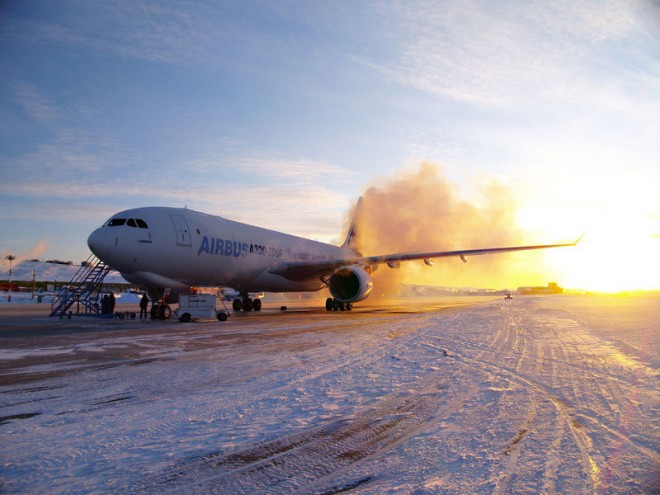 Don’t be freaked out by that eerie video of a Russian airliner skidding off an icy runway. Last year will go down as the safest year for airline travel since the dawn of the jet age more than 50 years ago.
Don’t be freaked out by that eerie video of a Russian airliner skidding off an icy runway. Last year will go down as the safest year for airline travel since the dawn of the jet age more than 50 years ago.
According to data from the Aviation Safety Network, an independent organization based in the Netherlands, there were 23 fatal airliner accidents in 2012, well below the average in recent years.
In terms of the total number of accidents for airliners, last year was the lowest since the end of World War II. The 23 accidents include air cargo aircraft, an airplane used to transport sky divers and a demonstration airplane from Russia. There were just 11 fatal accidents involving airliners, again the lowest number since 1945. The 10-year average for total airliner crashes is 34, and for passenger carrying aircraft, the average is 16.
Space Fence Program Will Help Protect Against Space FOD
Two Land-Based Radars Will Track Objects In Orbit Around Earth The Air Force Life Cycle Management Center at Hanscom AFB in Massachusetts recently put out a request for proposal to move the Space Fence program forward. Space Fence will be a system of up to two land-based radars, the first site located at Kwajalein Atoll in the Marshall Islands, to track objects entering Earth’s orbit.
Read More »
South Korea Develops Bird Strike Defense Robot
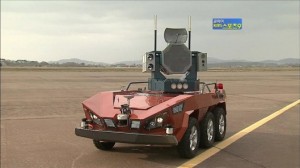 The Korean Atomic Energy Group and LIG Nex1 (an aerospace and defense subsidiary of LG Corp) have jointly developed what they are calling the world’s first bird strike defense robot. Birds are a major headache around military air bases and civilian airports all over the world, as they can cause significant damage when they collide with aircraft or get sucked into engines. The robot is a six-wheeled unmanned ground vehicle (UGV) that uses a combination of directional acoustics and laser patterns to scare birds away.
The Korean Atomic Energy Group and LIG Nex1 (an aerospace and defense subsidiary of LG Corp) have jointly developed what they are calling the world’s first bird strike defense robot. Birds are a major headache around military air bases and civilian airports all over the world, as they can cause significant damage when they collide with aircraft or get sucked into engines. The robot is a six-wheeled unmanned ground vehicle (UGV) that uses a combination of directional acoustics and laser patterns to scare birds away.
Read More>>



